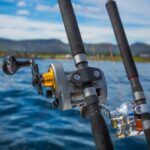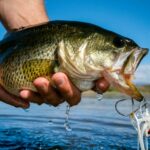Cast nets are important tools for any serious anglers, especially when targeting bottom-feeders, sport fish, or any form of carnivorous and predatory fish species. It can be almost impossible to catch good bait without a good cast net. Which size cast net should you use, and which is easiest to throw?
The cast net sizes that are easiest to throw are the smaller sizes, such as 3ft and 4ft nets. The larger the net is, the harder it is to throw. Smaller nets are easy to throw and control but are generally less effective than larger ones. 6 – 8 ft nets are the preferred size for most anglers.
There are several cast net sizes available, each with its own strengths and weaknesses, but all of them can be challenging to throw correctly. Deciding which cast net you should use is based on several factors, all of which are critical to the success of the net. Some anglers opt to use multiple cast nets of various sizes for use in different situations. There are many to choose from, so which is best for you?
What Size Cast Net Is Easiest To Throw?
Cast nets are the easiest way to catch multiple small aquatic creatures simultaneously. These nets are useful for catching fishing bait, such as baitfish, including bluegill, minnows, and shiners, or other bait items, such as shrimp and crab.
Cast nets are the best way to catch large amounts of bait or to maximize your chances of catching bait to use, regardless of the type of fishing you are doing, the type of water you are fishing in, and where you are fishing.
Cast nets are available in sizes ranging from 3ft to 16ft. Each cast net size has its own uses, and each size uses slightly different throwing techniques.
This wide discrepancy in cast net sizes, combined with the need for specific throwing techniques depending on the size of the net, leaves many anglers wondering which net size is the easiest to throw.
The easiest cast nets to throw are the smallest net sizes. 3ft and 4ft nets are typically considered the easiest nets to throw and are recommended for beginners and children.
The smallest nets require the least strength and force to throw. They can be used from any location or cast position in any type of water, and they require the least specific technique to use correctly.
The technique required when using a small 3ft or 4ft cast net is basic and easy to master. These nets are far easier to throw than the larger versions.
The difficulty of throwing a cast net scales in proportion to the size of the net. The largest cast net varieties are the most difficult to throw, require the most strength, and the best technique to use well.
However, the larger the cast net is, the more effective it is and the more creatures it can capture. This means that 3ft or 4ft cast nets are recommended for beginners and children, but most experienced adult anglers find that 6ft or 8ft cast nets provide the best combination of ease of use and efficacy.
Every angler must decide regarding cast net size, as everyone has their own preferences. It is also important to understand that different-sized cast nets can be used in different situations, so it is best to learn to throw as many cast net sizes as possible.
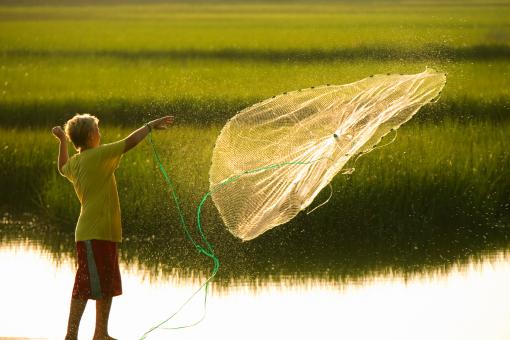
What Size Cast Nets Are Easiest To Use?
Using a cast net is more than throwing it. Deciding which cast net to use is not only based on how easy it is to throw, but other factors, including how difficult the net is to retrieve, play significant roles in the ease of use of a cast net size.
Cast nets are typically made in the same broad design, but they are made in multiple sizes and have multiple mesh sizes as well. Which of these cast nets is easiest to use overall?
The easiest cast nest to use, based on throwing and retrieving difficulty, combined with the weight of the lead used in the nets, the mesh size, and the potential catch in the net, are cast nets smaller than 8ft.
The length of a cast net is measured while it is closed. The length of a closed cast net is doubled in its diameter when it is open. This means that an 8ft cast net opens with a diameter of 16ft.
This is important when determining which cast net is easiest to use. How the net handles when it is closed and how it handles when it is open and retrieved with a potentially very heavy catch.
Cast nets become significantly more difficult to manage when they are open and even more so when they are full. The size of the net determines the size of its potential catch, which is also a consideration to remember.
Using an 8ft long or smaller net is the easiest option overall as:
- these nets can be thrown with relative ease
- they can be used in any type of water
- they are not so big that they become too heavy to control in the water
- or too heavy to move when they get wet
- they are small enough to be hauled out of the water by a single person when full
Cast nets larger than 8ft become exponentially more difficult to use overall and should typically be used by more than one person unless you are especially skilled at using a cast net.
If you are learning to use a cast net, cast from shore, or if you are not particularly strong, it is always best to use a net that is on the smaller end of the spectrum to ensure that you will get the most use from the net, and not become overwhelmed while using it.
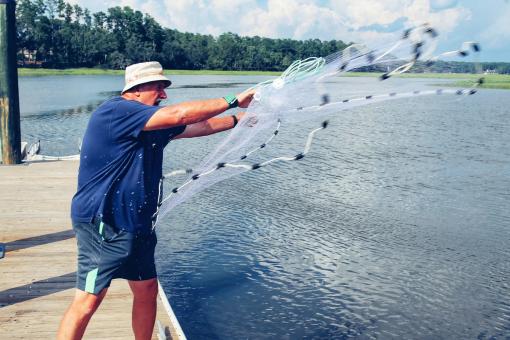
What Size Cast Net Is Most Effective?
We have established the easiest cat net sizes based on size and overall use characteristics, but which cast net size is most effective?
This question is slightly more difficult, as it has no straightforward or clear answer. The most effective cast net size is based more on the water you use it in, your cast location, and the fish you target with the net.
The number of fish you want to catch and the area you wish to cover while using the net are significant factors.
Generally, the most effective cost net size for most people is 6 – 8ft. This cast net size is the best combination of use, control, and effectiveness and is easy enough to use for almost any adult.
These nets can be used to catch a large number of fish and other creatures, as they open up to 12 – 16ft wide and are heavy enough and sink quickly enough to catch even the fastest-moving baitfish.
These nets can be used in the shallows or deeper waters, and they are large enough to be very effective for catching almost any type of small creatures or baitfish you may need.
However, smaller cast nets can be far more effective in shallow water or if you only catch one or two fish in the net. Smaller nets are easier to control, easier to cast, and easier to retrieve. This means they can be cast and retrieved much more quickly, increasing the turn-around time of the net, and making it more effective, especially in shallow water.
Large nets, 12 – 16ft long, are most effective for catching very large numbers of fish or other aquatic animals. If you only consider pure numbers when measuring effectiveness, the larger the net, the more effective it is.
However, these large nets are very cumbersome and difficult to use, making them very ineffective for a single person or a small fishing operation. They are only effective for fishing from large boats.
For the average angler, or even the professional one-man fishing operation, a cast net of between 6ft and 8ft is most effective.
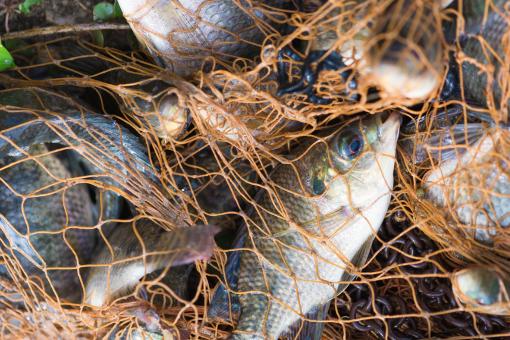
What Size Cast Net Should You Use From A Boat?
Other common questions regarding which size cast net to use are which nets should be used if you are throwing the net from land or a boat. Let’s begin with the best cast net size to use from a boat.
The best size cast net to use from a boat depends on the size of the boat and the number of people you have on the boat.
A large boat can easily make excellent use of a large, 16ft cast net. There is plenty of space to throw the net into, plenty of height to throw the net from, multiple people to help, and plenty of fish to catch with the net.
However, a small boat used by one person should not use a net larger than 6ft. Throwing a net larger than this can be very challenging from a moving boat, especially when fishing in freshwater. Standing and heaving a 10ft cast net into the water is likely to throw you into the drink if you are not careful.
However, using a smaller size cast net allows you to keep your balance and keeps the net in control at all times.
If you feel that you can handle a larger net, then the decision is yours, but a general rule is that small boats should use small cast nets, and large boats should use large ones.
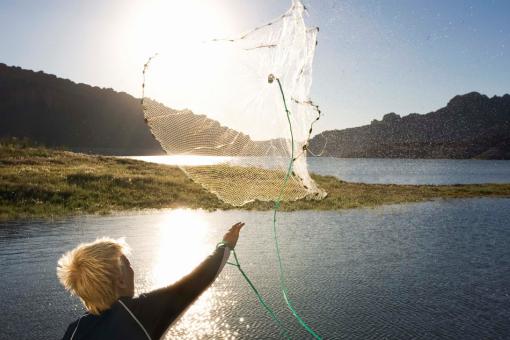
What Size Cast Net Should You Use From Land?
Using a cast net from land is very different from casting from a boat. Throwing a cast net from land, or at least from very shallow water, means you can be very stable on your feet, and you are likely to have much better leverage for throwing.
However, when casting from land, you must throw the cast net significantly further for it to be effective. Unless you are throwing from a dock or jetty, there is no way to get above the fish when using a cast net from land.
This means that using the lightest or smallest cast net that you can throw is best. The ability to throw the nest as far as possible when using a cast net from land is the most critical aspect to consider.
When standing in the shallows, all the fish and critters are likely to move away from you, which means you have to get them out and away from you to catch anything.
A small cast net, 3ft or 4ft in length, is always the easiest to throw, and these may feel useless due to their small size, but when you use a small net like this, you can throw and retrieve very quickly and cast very far away from you.
This typically yields the best results when using a cast net from land.
Unless you are particularly tall and strong and can use a 5ft or 6ft net in this way, a 3ft or 4ft cast net is usually the best option for cast from land.
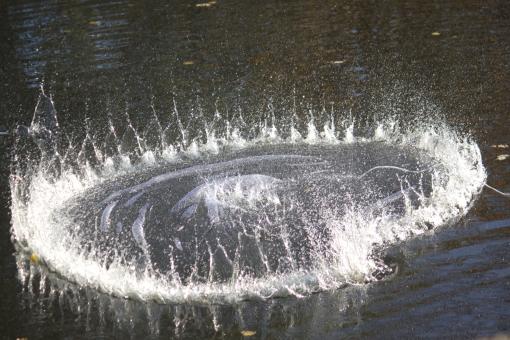
What Size Cast Net Mesh Is Best?
There is another critical aspect of cast net size that is very important to consider when determining the right cast net for you: the size of the net mesh.
The size of the net mesh determines the size of the fish and creatures the net can catch. If the net has a large mesh size, small fish and creatures can easily escape the net, and it is only effective for larger fish.
A small net mesh size can contain small creatures and fish, but it is generally heavier and more difficult to control, as there is more physical net to move due to the tighter mesh.
The size of the mesh also determines how effective the net is for retrieving fish, keeping them alive, and causing as little damage to the fish as possible.
If the mesh is slightly too small for a fish to escape through, it will try to escape anyway and end up becoming ‘gilled.’ This means that the gills scales of the fish get caught in the net, which could kill the fish, make it impossible to remove it from the net alive, or hurt the fish while being removed.
The best net mesh size to use is small enough to trap the fish or creatures that you are targeting without allowing them to become gilled and large enough that the net is still usable.
If you are after larger fish, use a large net with a large mesh. If you are looking for small baitfish, use a small mesh size and a smaller net.
A 1/4″ mesh size is best for small bait fish, and a 1″ mesh is best for larger fish. The combination that most anglers prefer is a 1/2″ mesh on a 6ft or 8ft cast net. This is usually the most versatile combination and can be used for catching most fish and small creatures.
However, if you only catch bait fish, using a tighter mesh and a smaller overall net size is best.
How To Decide Which Cast Net Is Best For You
The only important thing to know regarding cast net size is how to choose the right net size for you. There are many options to consider, but the only net you should use, especially when first learning to use a cast net, is the right net for you.
Here are some considerations to make when determining the best cast net for you.
Consider Your Skill Level
The first thing to consider when deciding on a cast net is your skill level.
If you are an experienced angler who would like to start using a cast net, you have probably seen someone else use it, or you have some idea of how they work. In this case, you can use a larger net, as you are likely to learn how to use it more quickly.
In this instance, use a 6ft or 8ft net.
If you have never used a cast net before, the best net to use is one that is smaller than 6ft. This size is the upper limit for a complete cast net beginner, but it will enable you to catch much fish, and it will train you to use larger net sizes quickly.
Consider Your Strength
The stronger you are, the larger cast net you can use.
A strong adult can use a much larger net than a child or a teenager, which should heavily factor into the net size you choose to use for fishing.
Consider The Your Target Catch
If you are targeting large numbers of fish, then use a bigger cast net. If you are only targeting a small number of fish, use a smaller net with which you can be more accurate.
If you are targeting a large species of fish or creature, a larger net will give you a better chance of catching it. If you are targeting a small animal, the net does not need to be very big.
Consider Your Cast Position
If you are cast from high up, from a dock, ledge, cliff, or a large boat, you can use a larger net more easily, as it has more space to open up.
Using a smaller cast net is far easier if cast from land or a small boat, as it does not require much time to deploy fully. If the net is not fully deployed when it reaches the water, it will not function well.
Conclusion
The smaller sizes are the easiest cast net size to throw, including 3ft and 4ft cast nets. These nets can be thrown the furthest, they are the easiest to control, and they are the easiest to manage. However, larger nets have their place, too, even if they are more difficult to use.
It is important to choose the cast net you use based on more than ease of use. Take your time to experiment and explore the various options to find the best net size for you, and choose the net based on its overall balance of effectiveness and use rather than just how easy it is to throw.
- Do You Need An Indicator For Nymph Fishing? - November 16, 2023
- Fishing Safety Tips For Families - September 25, 2023
- What Is The Best Time To Night Fish At A Lake? - September 18, 2023





